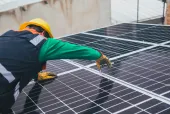
Why Indonesia's decision to turn to diesel gas for power production is "short-lived"
It is also expensive and risky, analyst says.
The announcement last week of new diesel gas contracts and more diesel-powered generators for power production in hundreds of locations across Indonesia is short-sighted, expensive and risky, according to the Institute of Energy Economics and Financial Analysis (IEEFA).
"While national government officials have stated support for renewable energy policies that would expand remote and rural electrification, including a plan to install solar photovoltaics in 2,500 villages in 2019 and 2020, the Indonesia electric monopoly PLN continues to plan for the procurement of diesel generators for up to 400 locations in Indonesia, all of which would be fueled by imported diesel fuel, according to Sara Jane Ahmed, an IEEFA energy finance analyst.
Renewable energy makes better economic sense for Indonesia’s many small islands and isolated locales. It allows for local energy security and saves money by reducing dependence on imported diesel.
Here's more from IEEFA:
Given the continued rapid reduction in cost of renewable energy, diesel generation by comparison risks burdening Indonesia with years of high-cost electricity delivered by outdated technology.
Indonesia has an opportunity today to move forward, instead of backwards.
Indonesia itself has an example for how modernization can work: On Sumba Island, the uptake of renewables has reduced electricity prices dramatically. In 2009, electricity produced by imported diesel fuel cost $0.26/kWh. But a 50 percent reduction in the use of imported diesel through storage, wind power, solar power, and hydro resulted in end-user cost savings of 35 percent, equivalent to approximately $0.09/kWh.
Sumba Island’s switch to a renewable micro-grid energy power also limited the need for costly new transmission and distribution infrastructure.
Solar-powered electricity costs have fallen by 99 percent since 1976 and by 90 percent since 2009, according to authoritative research by analysts at Bloomberg New Energy Finance. The cost of wind-powered generation has fallen by 50 percent since 2009.
As solar power, especially, is added to a grid, the cost of each additional unit of power goes down, a phenomenon that stands to drive solar’s eventual domination of energy mixes.
The Indonesian government, much to its credit, has embarked on the important task of increasing electricity access to remote and rural areas as part of its drive to achieve an electrification rate of 100 percent by 2024 (up from 85 percent in 2015).
Developing small island grids, as we explain in our paper, is an effective way to advance inclusive and modern development. And renewable technologies can complement these national objectives and drive economic growth by improving the affordability and reliability of electricity.
An electricity market free of subsidies can help Indonesia modernize by allowing for technology-agnostic procurement policies that will level the playing field an ultimately drive electricity rates down.
The key driver of electrification does not lie in subsidies for of imported fuels like diesel, but in delivering on government promises to embrace affordable, reliable, and secure renewable energy.













 Advertise
Advertise











